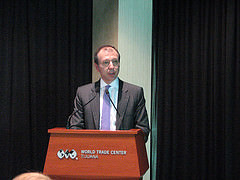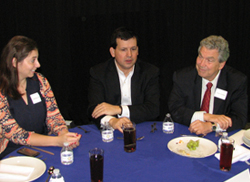The Center for U.S.-Mexican Studies (USMEX) and Washington-based Center for American Progress (CAP) organized and cohosted a one-day workshop Feb. 18 in Tijuana, Mexico. “Looking West: The Emergence of the Pacific Rim” was the third in a four-part series for CAP designed to generate debate about the U.S. and Mexico’s shared future.
Opening remarks were given by School of International Relations and Pacific Studies (IR/PS) Dean Peter Cowhey. Cowhey, who served a 12-month assignment as the senior counselor to the Office of the United States Trade Representative under President Barack Obama, outlined the day’s discussion that focused on Mexico’s competitiveness in the context of the Trans-Pacific Partnership (TPP).
“This is a terrific day to celebrate partnerships,” Cowhey said. “These partnerships between our countries and between our centers are really an exploration of hope and optimism, while recognizing the practical realities of the world.”
As senior council in the Obama Administration, Cowhey was responsible for helping to plan the U.S. trade agenda, which included the TPP. He outlined important implications of the trade agreement, should it be adopted, including large-scale intellectual property rights, and integrated production and sales that have the potential to exist outside China.
“The provisions in the Trans-Pacific Partnership will go further than any other trade agreement to truly make goods and services integrated in a way that allows for them to be packaged and delivered as solutions in the world economy,” he said. “The integration of information technology, information technology-related services, and goods themselves is a fundamental trend, and the TPP will allow it to take place in an accelerated way.”
Listen to Dean Peter Cowhey's opening remarks:
Outlining challenges
Panelists Diana Negroponte of the Woodrow Wilson Center for International Scholars, Juan Pardinas of the Mexico Institute for Competitiveness and Jaana Remes of the McKinsey Global Institute all commented on Mexico and the world economy.
CAP senior fellow Daniel Restrepo — a former principal advisor to Obama on issues related to Latin America and the Caribbean — moderated, and gave a public talk at UC San Diego the previous day that was hosted by USMEX and the Institute of the Americas.
In her remarks, Remes pointed out that China would potentially have 150 million fewer workers in 2025, making more room for Mexico to be productive on the global scale. She said maximizing trade opportunities like the TPP could coincide with maximizing productivity. Her McKinsey report “A tale of two Mexicos: Growth and prosperity in a two-speed economy” takes an economic look at Mexico 20 years after the signing of another large-scale trade pact, the North American Free Trade Agreement (NAFTA).
Negroponte used NAFTA as an example of Mexico’s integration into the North American economy as well, showing an important link to the global economy. She said the country needed to look outward and integrate to succeed internally, and would face external obstacles in the process: the fluctuation of gas prices, sinking value of the Peso and higher interest rates in the U.S.
“The TPP … becomes the necessary impetus for Mexico to start harmonizing regulatory frameworks and standards, recognizing that it’s not just with North America but with the other members of the TPP that [have to] change,” Negroponte said. “We have to have to the same standards when we produce gummy bears as when we produce medical instruments.”
Pardinas used his time to reference the series of 95 initiatives taken up by the Mexican government called the “Pact for Mexico,” which include key-sector reforms: education, energy, fiscal, security, political and telecommunications, among others. He said it would be difficult to find a country that has changed so much, so quickly in the last five years.
“What’s left to do is the most crucial and complicated reform, which is more than reform, it’s a revolution: to guarantee the rule of law,” Pardinas said. “The big challenge regarding how to integrate ourselves into the global economy is that we have to focus on the rule of law in Mexico.”
A dynamic world picture
 Following the discussion and audience questions, former Mexico Ambassador to China Jorge Guajardo gave the keynote address. Guajardo, who has frequently spoken on U.S.-China-Mexico relations since leaving his post as ambassador, was a Pacific Leadership Fellow at the Center on Emerging and Pacific Economies (EmPac), based at IR/PS.
Following the discussion and audience questions, former Mexico Ambassador to China Jorge Guajardo gave the keynote address. Guajardo, who has frequently spoken on U.S.-China-Mexico relations since leaving his post as ambassador, was a Pacific Leadership Fellow at the Center on Emerging and Pacific Economies (EmPac), based at IR/PS.
As a fellow, he spent two weeks meeting with UC San Diego faculty and students, visiting local and bi-national businesses, and gave a public lecture on campus.
“Mexico, like many other countries in the world, is still trying to figure out how to … include China in their planning. In the case of Mexico, we are both exporters of manufactured goods, so I think we are basically competitors on the international scene,” he said. Guajardo served as ambassador to China from 2007 – 2013.
In closing, Cowhey painted a “dynamic picture” for the region in the next 10 – 15 years, bringing the focus back to the U.S. and Mexico.
“The good news for both the United States and Mexico is this is a picture where, in a sense, there will be better balance — therefore better options — for everyone,” he said.
View the complete agenda (PDF) of the Feb. 18 conference, as well as Guajardo’s EmPac fellow website that highlights his campus visit.

